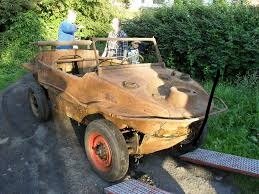1. Introduction to Schwimmwagen: An Uncommon Vehicle
The Schwimmwagen, an amphibious vehicle, is famous for its very unique and distinctive qualities. It was a special vehicle of Germany during World War II that not only could run on land, but also operated smoothly in water. It was built by Volkswagen, and its main purpose was to give German army troops the flexibility that other general-purpose vehicles could not.
The full name of the Schwimmwagen is Volkswagen Type 166, which was the most mass-produced amphibious car during WWII. The vehicle’s engineering was quite innovative—a complete blend of the ability to move efficiently on land and in water. As a result, it has become a timeless fascination for Schwimmwagen enthusiasts and collectors.
2. Short History of Amphibious Vehicles
It’s important to understand the history of amphibious vehicles in light of the Schwimmwagen as it reflects a significant evolution in technology. The concept of amphibious vehicles was first introduced in the 19th century when people began to explore seamless transitions between land and water.
First Concepts (1800s): In the late 19th century, many inventors began designing amphibious boats and vehicles. These vehicles were capable of running on both water and land, but did not have the efficiency to be useful for military or commercial purposes.
Military Applications (WWI and WWII): During World War I and WWII, amphibious vehicles were very important, as soldiers had to travel not only on tough terrains but also on water paths. This was where amphibious vehicles showed their worth and took the technology to a new level.
Post-War Development: After WWII, amphibious vehicles were no longer just for the military. They began to be made for civilian and recreational purposes as well. In the 1960s and 70s, replicas and amphibious vehicles like the Schwimmwagen attracted the attention of people around the world.
3. Schwimmwagen’s Role in World War II
The original role of the Schwimmwagen was very critical in WWII. The German army’s specialty of this vehicle was not only its amphibious capability, but also its lightweight and versatile design which made it easy to move anywhere. The Schwimmwagen was specially deployed on the “Eastern Front” and “Western Front”, where troops had to move across many rivers and waterways.

Design and Engineering Marvel
The Schwimmwagen required a lot of advanced engineering. Its body structure was extremely light weight so that it could run at speed on land and float in water. Volkswagen used its expertise to make the vehicle so perfect that it was reliable and effective even in tough environments.
Engine and Propulsion System: The Schwimmwagen’s engine was a 1,131 cc flat-four petrol engine derived from Volkswagen’s Beetle. This engine drove a propeller in the water which was manually lowered when the vehicle was in the water. This allowed the vehicle to move effortlessly on land and in water.
Four-Wheel Drive: This vehicle was quite advanced as it had a 4-wheel drive system, which gave very good performance on rough terrains.
Driving a Vehicle in Water: Schwimmwagen’s Amphibious Ability
The most impressive feature of the Schwimmwagen was its amphibious ability. This vehicle could enter water straight from the ground and float smoothly like a boat. This amphibious ability helped the German soldiers a lot in crossing difficult rivers and lakes, and allowed them to change their location quickly.
Steering System: While on land, the Schwimmwagen’s steering wheel controlled the front wheels, but in water the steering was done with a propeller that was controlled via a paddle.